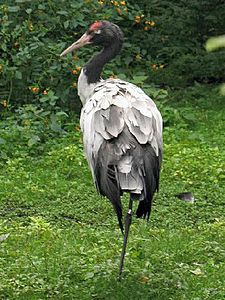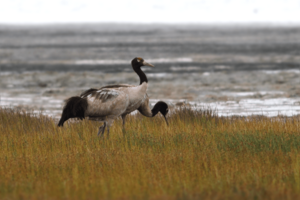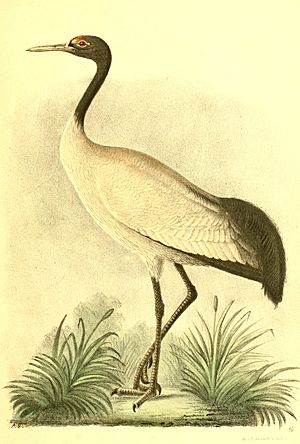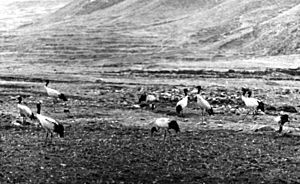Black-necked crane facts for kids
Quick facts for kids Black-necked crane |
|
|---|---|
 |
|
| Conservation status | |
| Scientific classification | |
| Kingdom: | |
| Class: | |
| Order: | |
| Family: | |
| Genus: | |
| Binomial name | |
| Grus nigricollis |
|
The black-necked crane (Grus nigricollis), also called the Tibetan crane, is a large bird. It is a type of crane.
It grows to about 139 cm (55 in) long. Its wings can spread up to 235 cm (7.8 ft) wide. This crane weighs around 5.5 kg (12 lbs). It is mostly whitish-gray. It has a black head and upper neck. There's a small red patch on its head. A white patch is found behind its eye. Its legs are black. The main wing feathers are also black. Male and female cranes look very similar. In Kashmir, this crane is a special regional bird.
Contents
What Black-necked Cranes Look Like
This crane is a medium-sized bird. It is mostly grey. Its head and neck are black. The skin on its face and top of its head is bare and dull red. You can see a small patch of white feathers. These are just below and behind its eye. Its tail is black. This black tail helps tell it apart from the common crane. Common cranes have a grey tail.
Where Black-necked Cranes Live

Black-necked cranes spend their summers mainly on the high Tibetan Plateau. They like to breed in certain places. These include high mountain meadows, marshes near lakes and rivers, and river valleys. They also use fields where barley and wheat are grown.
In winter, they move to sheltered valleys or lower areas. Most of these cranes live in China. Smaller groups are found in Vietnam, Bhutan, and India. Some have also been seen in northern Sikkim. A small group used to visit the Apa Tani valley in India until 1975. Some have even been seen in Nepal.
In 1996, about 4,000 of these birds were counted. Most of them spent winters in Tibet. They stayed in the valleys of the Nyanga, Lhasa, and Pengbo rivers. They also lived along the middle parts of the Yarlung Tsangpo river. The Hutoushan Reservoir in the Pengbo valley is an important winter home. A special area was set up in 1993 to protect them there. This area is called the Linzhou Black-necked Crane Preservation Zone. It covers 96 square kilometers (37 sq mi).
Black-necked cranes also spend winters in small numbers in two valleys in western Arunachal Pradesh, India. These are Sangti and Zemithang.
How Black-necked Cranes Behave

Black-necked cranes look for food on the ground. They often do this in small groups. One bird usually acts as a lookout. In winter, these groups arrive and leave feeding areas together. But they might split into family groups. Each family keeps its own small feeding spot in big marshes or fields.
They spend almost 75% of their day looking for food. They eat most in the early morning and late afternoon. While eating, they keep walking. They can walk many kilometers a day to find food. They eat roots of plants, earthworms, and insects. They also eat frogs and other small animals. Sometimes, they eat fallen grains like barley and oats. They might even dig up potatoes, carrots, and turnips. Their loud calls sound like trumpets, similar to other cranes.
These birds are very careful. But in some places, they are used to local people who do not bother them. These cranes seem to know the difference between people in traditional clothes and others. They are more careful around strangers.
Like many cranes, they are thought to stay with one partner for life. They do special dances during the breeding season. Breeding cranes protect their territory. They will chase away other cranes of the same kind. But they usually get along with other bird species.
Their nest is often on a mud island in a shallow wetland. Sometimes, they share this spot with bar-headed geese. The nest can be a simple scrape in the ground. Or it can be made of grass and weeds. Eggs are usually laid in May and June. They lay one or two eggs.
Parents are more careful when their young are small. The family stays near the nest until the young can fly. After that, they travel farther each day. Even when young cranes can find food by themselves, they usually stay with their parents. They use short, soft calls to stay in touch. Adults also use these calls to show young ones where food is. In Ladakh, adults were seen catching fish for their young, like herons do.
Protecting Black-necked Cranes
There are an estimated 8,800 to 11,000 black-necked cranes in the world. These birds are protected by law in China, India, and Bhutan. However, their homes are changing. Lakes are drying up, and farming is growing. These things threaten the cranes.
In many areas, dogs owned by herders are a big danger to young birds. Leopards have also been seen hunting cranes at night in Bhutan. In some places, cranes fly into power lines, which can kill them. Ravens might eat their eggs if people disturb the parents. If wetlands dry up, nests are easier for predators to reach. If water levels rise too much, nests can be flooded.
The biggest threats are losing and damaging their homes. This is most serious in their wintering areas. Here, human activities like irrigation, building dams, draining land, and grazing animals affect wetlands a lot. In Tibet, old farming ways have changed. This means less waste barley and wheat are left for the cranes to eat.
In Bhutan, cranes are well protected by culture and law. But some tourism can still disturb them.
Images for kids
-
A black-necked crane at the International Crane Foundation
-
From Phobjikha Valley, Bhutan
See also
 In Spanish: Grulla cuellinegra para niños
In Spanish: Grulla cuellinegra para niños






